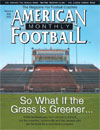AMERICAN FOOTBALL MONTHLY THE #1 RESOURCE FOR FOOTBALL COACHES
Article CategoriesAFM Magazine
|
A Big New Play from PasadenaStatue Play Confuses Defense – Pasadena College shows pass, delays, rushes to successby: Tom Maher Head Coach, Pasadena City College © More from this issue I selected the Statue play to write about because prep coaches and college coaches alike constantly ask me about it. It is simple to install and it’s a lot of fun. Statue is a glorified lead draw. It is a deception causing defenders to react to a pass. It is a mis-direction as the ball carrier runs off tackle away from the pass action. There is a significant delay before the ball carrier and quarterback exchange of the ball. We align in split backs. The QB takes a three-step drop and flags the ball at the backside wide receiver that is running a quick slant route. This receiver acts lik....The full article can only be seen by subscribers. Subscribe today!
|
|
|||||||
| HOME |
MAGAZINE |
SUBSCRIBE | ONLINE COLUMNISTS | COACHING VIDEOS |
Copyright 2025, AmericanFootballMonthly.com
All Rights Reserved





